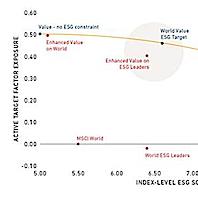MSCI launches new ESG indexes


Catholic Church Accelerates Divestment in Fossil Fuels


Today, approximately 40 Catholic institutions reportedly will announce that they will divest from fossil fuels. The total amount has not yet been publicly disclosed, but today's news follows the trend of Catholic organizations repeatedly announcing such divestment in tandem with global events, an example of which being the G-7 Summit this spring. Today's fossil fuel divestment is timed with the anniversary of the death of St. Francis of Assisi, the Catholic Church's patron saint of the environment and animals.
One year ago, a similar announcement, also timed with the anniversary of St. Francis's death, included seven Catholic organizations and was then touted as the largest faith-based divestment announcement ever.
A spokesperson from Caritas, a German Catholic relief agency that reportedly has assets worth $4.5 billion, told the Guardian that it would soon divest from any holdings tied to coal, tar sands and petroleum.
And the Italian town of Assisi, which the iconic St. Francis called home, is also joining this divestment movement, as both the local church diocese and the city's government said it will shed any assets linked to fossil fuels. "The Church that hears 'both the cry of the earth and the cry of the poor' cannot stay indifferent in front of the catastrophic consequences of the climate change that are unfairly affecting poor and vulnerable communities," said Assisi Archbishop Domenico Sorrentino in a public statement. "Taking the example of Saint Francis, we want to act to overcome an economic and energy system that is damaging too much our common home."
More Catholic organizations and faith groups have made such changes to their portfolios ever since Pope Francis issued his encyclical on climate change last year. "Doomsday predictions can no longer be met with irony or disdain," the pope had exclaimed in May 2016, and today's surge in divestment indicates Catholic organizations are putting his words to action.
Pope Francis has long been critical of the global energy sector and its rhetoric that its business practices help combat "energy poverty" by noting the many of the poorest communities worldwide are the most vulnerable to climate change.
The pope has continued his push to raise awareness of climate change. After hurricanes devastated much of the Caribbean along with parts of Mexico and the U.S., he attacked climate deniers as "stupid" and urged them to talk with scientists and review their work first-hand. And during his trip last month to Colombia, he urged the country's leaders to take action to "respect" its rich biodiversity and ensure that it is preserved for future generations.
Former United Nation's climate office head, Christiana Figueres, applauded this week's announcement. “I hope we will see more leaders like these 40 Catholic institutions commit, because while this decision makes smart financial sense, acting collectively to deliver a better future for everybody is also our moral imperative," Figueres said in a statement.
Image credit: UN Climate Action Program
Chefs In Puerto Rico Cook Up an Emergency Management Lesson for Trump


In past years, natural disasters brought presidents to devastated communities. It wasn't just considered politically correct for the country's leader to turn up and show his support for homeless victims of a hurricane, tornado, fire or flood. It signaled action. It urged sympathy and it prompted communities across the country to reach out.
"A visit from the president shines a light on the situation,” acknowledged an official of the George W Bush administration, Andrew Card. “He brings the national media. He brings attention. Americans are great at responding to a tragedy if they know about it.”
Former President Barack Obama touched down in Baton Rouge in 2016 after what was then the worst natural disaster of the decade. Bill Clinton was quick to show his support in North Carolina after Hurricane Floyd in 1999. Richard Nixon made his support known in Mississippi in 1969 after Camille ravaged the state. The tradition goes back as far as 1927 when Calvin Coolidge was nudged by Mississippi's governor to turn up and show federal support for flood victims.
But these days although presidential visits do seem to expedite federal dollars for aid, it's the gesture of the unexpected guest that can quickly marshal community resources that gets the spotlight.
Just days after Hurricane Maria bulldozed her way across Puerto Rico, renowned chef José Andrés and his crew from World Central Kitchen landed in the devastated city of San Juan and were handing out hot meals. Paella big enough to feed hundreds, sanocho, pastelon and other Puerto Rican favorites have made their way "to every corner" (Spanish) that can be reached in Puerto Rico. As of October 1, barely a week after two kitchens were set up on the island, more than 15,000 meals had been served, courtesy of local chefs, who donated their kitchens, local volunteers and food trucks.
And they haven't just been dishing out food. The team from World Central Kitchen (WCK), which includes chefs from across the globe are quickly becoming the face of disaster relief. After Haiti was devastated by earthquake, Andres realized that chefs with the talents and skills to adapt dishes to the local cuisine were what was needed to mobilize crews in disaster zones. A good hot meal doesn't just provide energy. It renews morale and incentivizes action.
Since that time, WCK has become a kind of melting pot of social action, with projects that address education, health and social enterprise in countries as far away as Zambia, Peru, Haiti and Brazil. Natural disasters help distill the urgent message of social action. But WCK's mission to overcome poverty in disadvantaged communities goes much further.
In Puerto Rico, Andres and his team set up a makeshift headquarters of tents, self-refrigerating trucks and camping stoves in the town of Santurche. They aim to turn out about a thousand meals per operation, "if God allows us, about 8,000 meals today [and] about 100,000 by Sunday," Andres said confidently.
Of course, Andres isn't just trying to mobilize Puerto Rico and the communities stateside. He's sending a message to President Trump and likely, the presidents of the future: You can do this, too.
On Sunday, Andres tweeted a list of helpful tips to Trump. They include emergency coping mechanisms that some of the hardest-hit communities have learned through adversity. The first: Harness your food trucks. The second: Thousands of rewarded volunteers can do the work of millions.
If I was.@realDonaldTrump I would activate every Food truck in the country,create blocks of 10,centralize kitchen, 20k meals a day per block pic.twitter.com/ChShkup7Mq
— José Andrés (@chefjoseandres) October 1, 2017
If I was .@realDonaldTrump I will praise in a tweet the thousands of volunteers organizing on their own to contribute to the efforts pic.twitter.com/tuluT8hLDC
— José Andrés (@chefjoseandres) October 1, 2017
Unfortunately, the lessons may come too late for Trump, whose late arrival will likely have spared him from seeing the raw misery addressed by NGOs and other organizations like WCK. In addition to Andres, there has been an army of celebrities and politicians who have moved quickly to fill the aid gap and are now assisting on ground.
In today's fast-pace world it would seem, it's the innovators with local connections and the professional skills to quickly assess the needs of thousands who can motivate action. And nothing, it seems, works as well in inspiring compassion to others than the need for a hot, well-prepared meal.
Images: World Central Kitchen
Why Racial Equality is Good for Business


A consulting firm specializing in social impact, along with a social equity think tank, together recently completed what they described as a six-month research project gauging how the business community can benefit from racial equity. Their conclusion: Companies across the U.S. are missing out a huge growth opportunity by not doing more to generate business value by advancing racial equality.
FSG and PolicyLink arrived at their analysis by interviewing over 50 business leaders in various industries across the U.S. Much of news on this front in recent months has been filled with ugly stories of supposedly forward-thinking companies dragging their feet when it comes to boosting diversity within both their employee and management ranks. Nevertheless, the study's authors say that tackling structured racism goes beyond moral and ethical arguments - or what as this movement's detractors often dismiss as "political correctness." Embracing America's demographic changes, as well as the wide racial gap in this country, can provide business benefits. And companies that have benefited in this study include several that have a reputation for being "hard-nosed."
Despite the macroeconomic statistics that can inspire politicians to ask, "what the hell do you have to lose," in trying to win over the loyalty of racial and ethnic minorities, the fact is that business is what can really drive and inspire change. After all, there is money within these communities. FSG and PolicyLink cite sources suggesting that the buying power of black ($1.3 trillion) and Latino communities ($1.6 trillion) should not be ignored. Businesses can pad their bottom line - but only if they adopt an approach tailored to meet the needs of these demographics.
At a higher level, the inclusiveness and effective targeting of these communities involve three steps. First, reevaluate markets and products, as in either servicing these communities in the first place, or develop goods and services that can meet the needs of these racial and ethnic groups. in addition, companies can reduce costs and risks, while improving productivity across their operations and supply chain, but committing to racial equity. Finally, companies should take steps to develop a reliable base of human capital and suppliers, boost consumer demand and improve the regulatory framework by creating new opportunities within these communities. Examples include the efforts of companies from General Motors to Symantec, and projects like boosting education programs in fields such as STEM or inculcating a culture of acceptance within a company.
Creating markets and economic prospects for workers in these communities is not all that different from what business administration students learn in class. Take the example of Brown's Super Stores, which operates 10 ShopRite supermarkets across the greater Philadelphia region. The company realized that while supermarkets in wealthier neighborhoods emphasized the customer experience, stores in lower-income neighborhoods tended to have poorer quality products while keeping more expensive items under lock and key - hardly a way to treat customers with dignity.
But Brown's Super Stores realized a cookie-cutter approach to opening stores in these neighborhoods would not work, so it organized town halls where locals could talk about their wants and needs. These stores' layout were redesigned and products were added to suit local tastes. Then, the company realized that many residents patronizing their stores lacked easy access to health care, so Brown's Super Stores opened health clinics and trained staff members on how to enroll customers in programs such as Medicare and Medicaid. The first seven of these stores that opened generated $250 million in revenues from areas that were once considered "food deserts."
Gap Inc, PayPal and Signa were additional companies the report cited as finding new sources of profit while boosting opportunities for people of color.
The report did not offer the standard conclusion; instead, it exhorted companies with steps on "how to begin." The bottom line is that the old lessons of putting oneself in another person's shoes applies. Understanding racial inequity is only the start: Businesses need to sort out how to translate that into action, and a change in mindset needs to start with the CEO. "Business executives therefore must take a fresh look at every aspect of their business operations," concluded the report's authors, "including product design and distribution, marketing and advertising practices, and hiring and personnel policies - through the eyes and experience of a person of color."
Image Credit: ShopRite/Facebook
Paper Doesn’t (Just) Grow on Trees: Rolland Innovates Smarter Paper


COMMIT!Forum will convene hundreds of corporate social responsibility leaders and CEOs from CR Magazine’s annual 100 Best Corporate Citizens ranking. The event includes a pre-conference workshop on integrated CSR and sustainability reporting from BrownFlynn. Join MGM's Chief Diversity and CR Officer Phyllis James, Terracycle CEO Tom Szaky, Leidos CEO Roger Krone on the corporate response to the opioid epidemic at the 2017 Commit!Forum in Washington, D.C., this October. 3p readers get 20% off with discount code 3P2017CF
Remember the paperless office?
As far back as 1975, futurists predicted the “end of paper” and the dawn of the paperless office. A quaint notion in 1975.
Some still claim the paperless office is coming. Maybe so. I am no futurist, but I find it unlikely. I’m not the only one.
Patterns of consumption have evolved in tandem with technology. In some situations, paper consumption is greatly reduced. But our “paperless offices” are still drowning in paper.
Between 1980 and 2000, global consumption of paper increased by half.
It is arguably counter-productive to think our modern business world will ever be entirely “paperless.” Focusing instead on production, consumption, and the supply chain connecting all stakeholders can lead to a sustainable “Less Paper” society.
Though "Smarter Paper" may be a more accurate moniker.
A world built on paper
Manufacturing paper isn’t typically considered an environmentally benign process. Paper production is an energy and water-intensive, chemical-laden, resource-extracting activity. Forty percent of global logging activity goes toward making paper. Up to 4 billion trees.
Paper production is the world’s third most energy-intensive industrial process, using 12 percent of the energy consumed by the industrial sector.
We shouldn’t just throw shade at paper production. In a very real sense, paper, in all its forms throughout history, is what makes us human.
Even as it must share with the cloud its role as a means of storing, sharing, and transferring knowledge, paper remains an essential element of modern society, culture, and civilization.
The nature of paper production combined with its importance to humanity offers significant opportunity to advance a smarter paper society.
In his June 20, 2016, article Whatever Happened to the Paperless Office, Nick Booth presents a sobering assessment of current trends in paper's global footprint. But he also shows choices companies and consumers can make to reverse those trends: "Another pollution nullifying strategy is to use paper companies that have modified their production processes to cut the formation of dioxins."
What does such a company look like?
Rolland: An enduring commitment to quality
Jean-Baptiste Rolland was a Canadian printer and bookseller. Born into modest circumstances in 1815, as a young man Rolland left his home of Saint-Hyacinthe, going to Montreal to make his mark in the world. By the 1850s, Rolland had built a prosperous business and a trustworthy reputation.In 1882, Rolland, in partnership with his two sons, opened a small mill in St-Jérôme to support their publishing efforts. Rolland Paper, a purveyor of fine quality papers, was born. The company went public in 1928.
If much has changed since its launch in 1882, one thing remains the same: Rolland's commitment to quality and innovation. In 1955, at the behest of Lucien Rolland, the company completed a vast modernization and expansion project.
Along with new machines capable of increasing production capacity from 27,000 to 57,000 tonnes per year, the mill in St-Jérôme was retrofitted with a water pollution control plant. This was a glimpse of company's evolving philosophy of environmental stewardship.
Lucien was the last Rolland to run the business. He and his forebears laid the foundation
In 1992 Cascades acquired Rolland Fine Paper to form the Fine Papers Group of Cascades.
"Cascades fundamental philosophy was also very innovative," Michele Bartolini, Rolland Director of Marketing told TriplePundit in a recent interview. "The organization encouraged innovation,"
One prime example of the innovative spirit comes from the local landfill.
Biogas
Rolland operates the only paper mill in North America powered primarily with biogas. This transformation in the early 2000s from coal-fired energy to 93 percent biogas began as a suggestion from an employee.
In 2002, the Director of Purchases watched a TV documentary about energy and carbon emissions. The program inspired him to dig deeper into what his company could do about it. After researching the idea of using biogas produced from decomposing landfill waste, he took his concerns to management.
Long story short, within two years, the company had forged community partnerships, built the infrastructure, and began powering their mill operations with renewable biogas from a nearby landfill in Sainte Sophie.
An eight-mile-long pipeline brings purified methane gas (AKA natural gas) captured at the landfill managed by Waste Management The pipeline and gas delivery is handled by Gas Metro. Win-win-win.
The arrangement reduces Rolland's CO2 footprint by 70,000 tons or the equivalent of taking 23,400 compact cars off the road for one year.
As the reincarnation of paper progressed, it was time for yet another major milestone for the company
Life Cycle Assessment
In 2014, Cascades sold the Rolland subsidiary to HIG Capital.
"One of the main reasons (HIG) purchased the company," says Bartolini, is "because of the philosophy."
That same year, Rolland Enterprises conducted its first company-wide Life Cycle Assessment.
LCAs aren't uncommon in the industry, Bartolini explains. "Most (paper companies) have conducted a lifecycle assessment in America and in Canada," she says. "The only difference is they do not publish (their LCA) and we do."
“Our LCA is the reflection of our integrity,” Rolland Enterprises President Philip C. Rundle recently told Graphic Arts Magazine. “Not only does it confirm the environmental stewardship of our products, it also confirms our willingness to openly share our findings.”
To date, Rolland has commissioned two Life Cycle Assessments. One in 2014 and another in 2016. Both conform to ISO 14040-14044 standards for LCA studies with comparative assertions intended to be disclosed to the public. Results and conclusions were therefore subject to a formal peer review process.
Transparency: the currency of sustainability
Transparency is key, an enduring lesson of history that often requires relearning as new circumstances arise. The Life Cycle Assessment (LCA) is an important mechanism for triple bottom line transparency. But is only a mechanism, not the end result.
We all know that you can't manage what you don't measure. Once you've measured, however, it's time to manage. For Rolland, the LCA is not a set piece, but a living, breathing plan of action.The iterative process identified a "gap" in water consumption. Acting on that
The 2014 LCA identified a "gap" in water consumption, allowing the company to iterate their water recycling methods. In 2016, the assessment confirmed a 30 percent reduction in water use.
Progress.
But nobody goes it alone.
It takes a village
Sustainability can be a slippery term. Greenwashing is still a "big problem" Bartolini says. Certainly, there will always be leaders and followers, but as companies and consumers become more hip to the difference between green and greenwash, maintaining a position of sustainability as no more than a marketing ploy becomes increasingly untenable.The lesson from Rolland is that "sustainability" is an iterative, holistic process. There is no one single element that makes any industrial process sustainable, nor is the journey ever really done.
In the end, it takes a village. Each step in the process, from energy and sourcing recycled fiber to working with trucking companies or ensuring virgin fiber comes from FSC chain-of-custody certified forests, embeds further into the mainstream the ethos of responsible business.
In the process, Rolland attracts many like-minded organizations as customers. Rolland is not in the business of only providing quality recycled paper. It is in the business of offering a variety of products produced and distributed in the most socially and environmentally beneficial means possible. And then iterate on that process, doing better with each step.
As Bartolini says, "Our objective is to make the best recycled paper, maintain the smallest environmental footprint, and help our customers maintain sustainable supply chains."
After all, paper doesn't just grow on trees. It takes a village.
Images credit: Flickr/ David Pursehouse; Rolland Paper
All Hands on Deck: Cultivating Resilience in the Face of Disaster


By Daphne Stanford
Current attempts at federal aid for victims of natural disasters are inadequate. What, then, are we to do? Sustainability-minded companies, social workers, and civil engineers are all working in different ways to design buildings with sustainability, efficiency, and natural disasters in mind.
According to Annie Muldoon, “Attempts to improve social conditions may be lost if society itself lacks clean air, drinkable water, and adequate food.” She continues:
It is quickly becoming evident that the groups who are most immediately and profoundly affected by environmental destruction are those who face multiple systems of oppression. These include women, the poor, people of [color] and people who reside in nations of the global South.Does any of this sound familiar? Readers of TriplePundit realize this as a non-issue: sustainable retrofitting, microgrid technology and preventative city planning are all worth the effort, but how do we convince others? How do we reach those who simply don’t believe climate change is real? Many say those people are beyond hope, and that we should focus on our representatives. But what do we do when our representatives participate in group-think, when they are more concerned with the financial support of wealthy donors than the truth?
Sustainable Policies & Preventative Infrastructure
We need a three-pronged approach: utilize logic, rationality, and critical thinking skills to explain climate-related disasters to others in simple terms; appeal not only to rationality but emotion, spirituality, and ethics; and invest in companies and organizations interested in divesting from fossil fuel companies unwilling to commit to a sustainable, equitable, and long-term clean energy agenda.
Moreover, the issue of divestment is only one part of the picture. We can talk about clean, sustainable energy consumption all day, but unless we go out into the field and put sustainable building standards into practice in our communities and via clean energy policies and legislation, we’ll merely be preaching to the choir.
Civil engineers, for example, typically work for construction firms, consulting, government, development firms, the military, or non-residential building construction. Because they tend to deal with larger-scale building development directly connected to urban design and city-wide efforts, they can also provide input about sustainable design features and green retrofitting — a practice we will need more of over the next decade.
If we treat this as a human rights issue — as well as an issue of energy policy, city planning, and civil engineering — there may be some hope for our cause, yet. Nicholas Kristof understands this; Amnesty International understands this; Jimmy Carter understands this. However, many voters left-of-center, galvanized against a broadly-painted swath of “religious right,” still fail to understand this.
Religiosity does not necessarily equate to opposition to clean energy policies. The support is there, but it’s not headline-worthy, so the clickbait goes elsewhere. Maybe supporters of sustainability need to start speaking in ways that rural America can understand. By using terms like ‘evil,’ ‘immoral,’ and ‘unethical,’ we can draw attention to the ethical problematics of ignoring humanitarian crises.
Hurricane Maria & Puerto Rico: What Can We Do?
The current fallout from Hurricane Maria in Puerto Rico — specifically, the sluggish U.S. response to our citizens who live there — is a massive problem. However, because Puerto Rico is a territory, rather than a state, they have no official representation in Congress. Moreover, the Trump administration is delaying the necessary resources Puerto Rico would be able to afford if the Jones Acts were suspended (or, better yet, rescinded), as it was for Hurricanes Harvey and Katrina. This is because of some supposed adherence to fiscal responsibility — but there will also likely be a massive exodus from Puerto Rico to the mainland, because of the impending infrastructure collapse.
Numerous companies have stepped up to help donate funds and supplies to relief efforts. However, as long as the current administration fails to waive or rescind the Jones Act, their efforts are bound to fall short of the massive infrastructure rebuilding that is now needed.
An increased level of CSR-related funding is certainly not without widespread support. In fact, more than 90 percent of U.S. employees consider social responsibility to be a priority while 62 percent also cite sustainability as an important consideration
A Call to Action
So far, the current administration is succeeding in distracting and dividing us enough to make enough people believe there’s nothing that can or should be done to help those in need. What can we do? We can sign petitions and call our representatives in Congress. We can raise awareness among our friends and family. And we can donate to legitimate relief efforts conducted by locals on the ground who are well-connected, both geographically and culturally.
The humanitarian crises in Bangladesh, Puerto Rico, the Virgin Islands, Barbuda, and other parts of the Caribbean and southern United States are making one thing clear: we should prepare for mass exodus of people displaced from these areas into other parts of the world — including within the U.S. If you’re looking for a place to start, Lin-Manuel Miranda has written about the Hispanic Federation, a New York-based relief fund sending charter planes with supplies directly to Mexico and Puerto Rico.
This should go beyond politics. Human lives are being sacrificed because of petty socioeconomic, cultural, and political hang-ups — as well as, let’s face it, racism. There is a lack of understanding of the larger issues, here.
Civic representatives, civil engineers, and corporate sustainability advocates can work with healthcare and social work organizations dealing with humanitarian aid crises to get help to the places that need it most — but only if our president can look beyond personal and political grievances to recognize his duty to the people he supposedly governs, protects, and defends.
Where will people go? It’s likely they will relocate to places affordable enough to sustain them. For example, rather than big cities, smaller towns closer to more sparsely-populated areas of the country are likely to be popular. Perhaps when more U.S. citizens see other U.S. citizens relocating to different regions of the country for a habitable place to live, they’ll realize the future humanitarian crises brought on by climate change will need answers, and quickly — before time runs out.
Update: Immediately after this article was written, the Trump administration decided to temporarily waive the Jones Act for ten days. However, they refrained from nixing it altogether, meaning Puerto Rico will likely have to grapple with the economic consequences of Hurricane Maria for much longer than would be the case, if the Jones Act were permanently rescinded.
Image credit: The National Guard
Daphne Stanford hosts “The Poetry Show!” on KRBX, her local community radio station, every Sunday at 5 p.m. A writer of poetry, nonfiction, and lyric essays, her favorite pastimes include hiking, bicycling, and good conversation with friends and family. Follow her on Twitter @TPS_on_KRBX.
The Hydrogen Fuel Cell Secret Behind GM's Big EV Announcement


GM sent a ripple across the web on Monday with the attention-grabbing announcement of its "path to zero emissions" plan, which includes an impressive lineup of at least 20 electric vehicles by 2023. To the casual observer, that means a head-on collision with Tesla, but GM adds an interesting twist. Instead of only offering battery-powered EVs, GM will include a healthy dose of EVs that run on hydrogen fuel cells.
That's a surprise move considering the intensive criticism that hydrogen fuel cell vehicles have endured, so let's take a look under the hood and see what's going on.
GM's big EV announcement...
GM's announcement was pretty thin on details, but it looks like the company is convinced that the all-EV future is immanent. Here's the explainer from Mark Reuss, General Motors executive vice president of Product Development, Purchasing and Supply Chain:
General Motors believes in an all-electric future. Although that future won't happen overnight, GM is committed to driving increased usage and acceptance of electric vehicles through no-compromise solutions that meet our customers' needs.
The news is not exactly a bolt out of the blue, so to speak. Though GM's first foray into the EV market was a flop -- it introduced the ill-fated EV1 all the way back in 1996 -- in recent years the company began changing hearts and minds with its gas-electric hybrid Chevy Volt, and followed that up with the highly regarded all-electric Chevy Bolt.
The Volt seems to be taking a back seat when it comes to the EV of the future. The Volt has a gasoline tank to cushion drivers against battery range anxiety, and drivers seem to be responding nicely to the mix (a gas-powered generator kicks on when the battery runs out, so the car always runs on electric drive no matter what). However, GM is convinced that all-electric cars are the wave of the future:
In the next 18 months, GM will introduce two new all-electric vehicles based off learnings from the Chevrolet Bolt EV. They will be the first of at least 20 new all-electric vehicles that will launch by 2023.
...is all about hydrogen fuel cell vehicles
So, here's where things get interesting. Like practically every other major car maker except Tesla, GM has been tinkering around with hydrogen fuel cell vehicles.
Hydrogen FCEVs run on electric drive, just like the more familiar battery-powered EVs. The basic difference is that batteries need to be charged up, while fuel cells generate electricity on-the-go.
GM is no newcomer to fuel cell technology. The company first introduced an "Electrovan" hydrogen fuel cell demonstration vehicle in 1966. The concept went into the deep freeze for a while but roared back into life in 2013, when GM and Honda announced a fuel cell collaboration. In 2016 GM dropped another strong hint that it was planning on a fuel cell future, and earlier this year GM and Honda announced they would partner in a new $85 million fuel cell plant in Michigan.
Meanwhile, GM has been working with the U.S. Army on bringing fuel cell technology to the Defense Department's vehicular fleet. In 2012 GM helped the U.S. Army establish its first hydrogen fuel cell EV fleet, and the company is also developing the ZH2 tactical fuel cell EV for the Army.
This is all happening despite persistent criticism from Telsa co-founder Elon Musk, who has famously referred to fuel cell technology with a curse.
GM's new EV announcement blithley steps over that remark:
GM also introduced SURUS — the Silent Utility Rover Universal Superstructure — a fuel cell powered, four-wheel steer concept vehicle on a heavy-duty truck frame that’s driven by two electric motors. With its capability and flexible architecture, SURUS could be used as a delivery vehicle, truck or even an ambulance — all emissions free.
If you caught that thing about trucks, you're on to something. Though EV battery technology is improving and will continue to improve, GM is among the carmakers looking to fuel cells for powering SUVs as well as medium and heavy-duty vehicles.
But what about the hydrogen?
The missing piece in all this is a sustainable fuel supply chain. Like their battery EV cousins, hydrogen fuel cell EVs have zero emissions at the tailpipe. That's all well and good, but if you're charging up your battery from a grid that includes coal and natural gas -- or if the hydrogen for your fuel cell is sourced from natural gas -- then your EV is not as sustainable as it could be.
The picture is rapidly changing for battery EVs. Coal is toast, renewables are beginning to edge natural gas out of the grid, and battery EV owners have the potential to source their own electricity from rooftop solar arrays.
Renewable options are also beginning to emerge for hydrogen with the advent of biogas as a source instead of fossil natural gas. "Water-splitting" technology powered by solar or wind energy is also paving the way for sustainable hydrogen fuel.
GM is looking ahead to a more sustainable manufacturing model, too. The company recently announced a big wind energy buy for electricity to power its factories in Ohio and Indiana.
Image (screenshot): via GM.
EasyJet: All-Electric Plane Possible in 10 Years


The British discount airline easyJet made waves over the past week in announcing a partnership with U.S.-based Wright Electric to develop an all-electric commercial airplane that could launch within a decade. According a public statement, such aircraft would help the company "progressively decarbonize and reduce noise from aviation operations."
According to several sources, including the Guardian, the goal of this partnership is to develop aircraft with a maximum range of the 335 miles - long enough for an easyJet flight departing its Luton Airport hub to reach cities such as Paris, Brussels and Amsterdam. Beyond the obvious environmental benefits such as far lower carbon emissions, an all-electric plane would benefit neighboring airport communities by reducing noise at take-off and landing by at least half.
EasyJet touts this strategic plan with Wright Electric as building upon its sustainability agenda, such as its announcement earlier this year that several operational changes have allowed the company to decrease its carbon footprint by a dramatic rate.
A few words of caution, however: the company has a history of making splashy headlines. In February 2016, easyJet's founder opened a discounted private-label food store in a move to address London's pricey cost of living and stubbornly high poverty rate. The store closed within two days and never reopened. Days later, the airline announced plans to develop a hybrid airplane powered partly by hydrogen, but the company has since been silent about that project's development.
Questions about easyJet's commitment to transforming aircraft technology also arise when the airline oddly announced that in addition to this "collaboration" with Wright Electric, the company was offering free inflight entertainment on passengers' electronic devices - which in reality would be far more interesting to easyJet's consumer base than a clean energy technology that may, or may never, power airplanes by 2027. As airlines come under repeated scrutiny for their contribution to climate change, headlines like those of easyJet are one way to reassure stakeholders that they are committed to "sustainability."
So what gives? Is easyJet really committed to an airplane that would be a huge step in reducing the air travel industry's carbon emissions? And considering the improvements, yet challenges, electric car brands such as Tesla, GM's Bolt and the Nissan Leaf have had with range, are fossil fuel-free commercial flights even possible in the near future?
NASA believes so. The agency has been working on a project, LEAPTech, that a redesigned propulsion and airframe, along with electric power, can eventually be applied to more aircraft so that they can become more efficient, safer and of course, fly with a lower environmental impact. For now, experiments have been conducted on the ground, but NASA researchers are hopeful that a demonstration "X-plane" with this technology can start flying within a couple years.
Timothy B. Lee of Ars Technica also suggests that the plans put forth by easyJet and other companies are "more than a fantasy." Noting that battery technologies are improving at an average rate of 7 percent annually, batteries 10 years from now could hold twice as much energy as they do now. But the huge obstacle the aviation sector faces is that the energy density of jet fuel is far higher than that of batteries, so after take-off, much of the range of an electric airplane would be quickly zapped. Lee suggests at the moment, it is a stretch to suggest an all-electric plan could leapfrog aircraft powered by conventional fuel. A hybrid design, which would also require a complete redesign of commercial jets, would be a more realistic path during the 2020s.
To that end, one startup, Zunum, is designing a hybrid jet that incorporates a revamped propulsion system with a jet fuel-powered turbine to keep a plane flying when battery power diminishes. As it stands, such a plane's environmental and economic credentials are not shabby, with fuel cost savings ranging 40 to 80 percent in addition to potential noise reduction of 75 percent. Zunum envisions such airplanes to have a range of up to 700 miles, which could also lower the cost of flights to smaller cities.
As Los Angeles Times reporter Samantha Masunaga noted, conventional aircraft are fast and efficient because jet fuel allows for relatively simple forward thrust. In contrast, electric planes fly far too slowly. Furthermore, while battery technology keeps improving, they are still too heavy. The Boeing Dreamliner, for example, weighs about 500,000 pounds. Masunaga quoted an aviation professor and researcher who claimed that if the same plane were all-electric, it would weigh 4.5 million pounds. So even for smaller planes, the bar for more efficient flying is still high.
Finally, there is the huge challenge of sourcing enough lithium and other elements that allows for efficient energy storage - unless alternative technologies can prove to be effective and scalable.
Nevertheless, electric airplanes are well worth the research and development. After all, the sector is well aware of its growing environmental footprint; and the need for less conventional jet fuel could result in less volatile expenses in the long run.
Image credit: Aero Icarus
Is the Next Generation Ready for the Sustainability Challenge?


On September 26, TriplePundit hosted the #Whypurpose Twitter chat on the potential and need for engaging Millennials in sustainability issues. Encouraged by the chat, Joanne Sonenshine and Marc de Sousa Shields continued the discussion. This excerpt of their conversation is a testament to how invigorating dialogue encourages thinking and, hopefully, leads to action.
Marc: Joanne, if the world is to avoid looming environmental global calamity, we must necessarily transition to a low-carbon economy. I think we agree on that!
We also know it’s going to happen by design or disaster. As an early Gen Xer, I feel bad we are dumping this on the Millennials. They are going to have to make the changes to production and consumption habits we could never manage if climate change is to be stopped and biodiversity regenerated to sustainable levels.
Many see light in “purpose-driven” Millennials. I’m not convinced they are ready for the sustainability challenge. What do you think they can accomplish as employees and business leaders?
Joanne: Marc, don’t you find the concept of trying to “win over the Millennials” a bit exhausting? True, they are shaping up to be a very influential generation in terms of spending and work habits, but are we focusing too much attention on their role in reshaping corporate engagement and defining purpose?
There is no end to the books, articles, even public relations firms dedicated to “influencing millennials.” Can they turn the sustainability tide – climate change, overconsumption, food waste and resource burnout?
OK, all that said and even though I am not one (just barely), Millennials are a real phenomenon. Fast at everything and prone to immediate gratification, is there a place in their so called purpose-driven world for sustainability issues?
If the attention placed on this generation of ChangeSeekers means that companies and decision makers shift their time and energy to making the bottom line about their impact on the planet, then it’s all for a good reason. It’s up to all of them to be pushy in that regard.
What about you? As a fellow Gen Xer/cuspy Boomer, where do you think the sense of purpose will take us in the next generation?
Marc: I am divided, Joanne. Truly. Part of me wants to believe Millennials will be different. I did some research on the topic, and found that of the 20 or so Millennials I interviewed about sustainable investment habits, most tended to regress to the fairly typical (unsustainable) middle-class American lifestyle as they aged.
I could easily be convinced that Millennials will not be much different than us, but my question to them is: is growth economics generally, mortgages and expensive educations specifically, something you really want? My reading is not really, and that “purpose” for Millennials means greater work-life balance, and doing what they love: a good start but hardly leading to sustainable economies.
Joanne: I do get the sense this is the case. But countless Twitter and LinkedIn posts tell me that purpose does seem to trump economics when it comes to this generation.
There is a part of me that suspects the Millennials assume it’s easy to have both purpose and material advances, which may be true in some instances, not true in others. Do you think it’s realistic to encourage this generation that they can “have it all?” Or are we overpromising?
Marc: I wish I knew the answer to that one Joanne. But I think we can say three things about it with some certainty.
First, there are some fine efforts supporting a more purpose-driven world that can lead the way. TriplePundit’s #WhyPurpose Twitter chat leaders – Pearson, Walton Initiatives, PRME Secretariat, NetImpact – all have great ideas and resources.
Next, Millennials are on the cusp of redefining what constitutes value, with time and passion being more important than stuff. Again, this is an excellent starting point, and goes much further than us Gen Xers who wanted something similar but ignored ourselves and jumped to material consumption hyperdrive.
Last, it’s in Millennials' hands to decide. They soon will be the majority of business leaders and employees. It's their choice.
Can you see something my failing Gen X eyes are missing?
Joanne: I keep going back to the notion that successful sustainability and protecting the future of the planet are up to all of us, regardless of our generation.
Maybe Millennials spend too much time “sharing” ideas on social media to really act on their purpose? Are they taking the risks required to reshape the economy? Is all this Snapchatting leading to something more? I’m not just talking about Silicon Valley-type change, nor the challenges of reshaping products and services either. That’s the easy part. The harder part will be about companies melding ideas from employees of all ages in crazy, fluid and innovative ways.
So, I guess, the big question is: Does desire for purpose lead to action?
Marc: I hope so, and if I could have just one wish, it would be for Millennials to get far more pushy and disruptive about the purposeful change the want.
Joanne: That resonates with me, too. I like action and am not one to sit around and wait; its on us to act or not. Let’s not wait for the ‘other people’ to fix our problems. If we don’t do our best to make the world a better place for ourselves, we certainly won’t have the ability to blame anyone but ourselves when it all falls apart (which we’ve seen too much of lately).
Marc: Amen to that, Joanne.
Marc de Sousa-Shields is a writer on sustainability issues, advisor to the UN, and author of Invest Like You Give a Damn (New Society Publishers, forthcoming Nov. 2017).
Joanne Sonenshine is Founder of Connective Impact, a partnerships strategy and collaboration advisory firm, and author of ChangeSeekers: Finding Your Path to Impact.
World Economic Forum Challenges Businesses to Support LGBT Equality, Even in Countries Without Equal Rights


LGBT rights have come a long way in many countries, but in much of the world, society is still steadfast in its opposition to equality on this front. The problem for many multinational companies is when they have solid LGBT equality policies on one hand, but are conducting business in countries where full equality of its citizens are a non-starter - with the argument that such acknowledgment of rights clashes with "local culture and traditions."
Starbucks was one company that was recently caught in the crosshairs between its support for gay employees and citizens and activists in Indonesia and Malaysia. An organization urged Indonesia's government to suspend the coffee giant's operating license as its commitment to the LGBT community was "not in line" with the country's social norms. Disdain amongst some citizens in Indonesia for Starbucks dates back as far as 2013, when during at a shareholder meeting, then-CEO Howard Schultz defended the company's policies to a shareholder by saying, "not every decision is an economic decision," and that those opposed to Starbucks' stance on gay rights could simply sell off their shares.
According to the World Economic Forum (WEF), Starbucks serves as a case study for companies that find themselves embroiled in such a controversy: do not get bogged down in the dispute, but at the same time, do not back down from any commitment to diversity, inclusion or equal rights.
Companies may find that they are caught in the middle, as what may seem as a basic tenet of human rights to one group is outlandish or offensive to another. But the evidence suggests that standing one's ground can help a company ensure such such a firestorm. WEF cited a study from the marketing communications consultancy Oglivy from earlier this summer. That survey concluded 46 percent of Americans agreed seeing a company's advertising campaign inclusive of LGBT-related themes would make them more inclined to purchase that company's goods or services. That percentage may not inspire confidence at a first glance; but marketing messages are quite fragmented today. Oglivy's research actually presents quite a strong number: 48 percent of the same people surveyed said they would avoid patronizing a company with a known reputation for discriminating against LGBT citizens.
And companies can also find opportunities to boost trust for their brands, as well as inspire other companies to support the rights of the LGBT community. Here in the U.S., the response of companies to the "bathroom bill" in North Carolina subjected the state's leadership to unflattering headlines and lost business as companies from Bank of America to NASCAR spoke out against the legislation. And earlier this summer in Singapore, a local LGBT rally raised 60 percent more in sponsorship money from local companies - even though local regulations were written to prevent foreign companies from supporting the event. In one word, support for LGBT rights comes down to one word: leadership.
Along with the United Nation's Human Rights Office, WEF is urging companies to companies to enact anti-discrimination policies, establish solid employee grievance procedures and perform due diligence. The organizations also say it behooves companies to ensure all employees have equal benefits and that managers are aware of such policies in order to ensure such protections are extended to LGBT customers, suppliers and distributors. In a nutshell, companies that lead by example for LGBT rights will nudge more companies to follow.
Image credit: Jnzl's Photos/Flickr